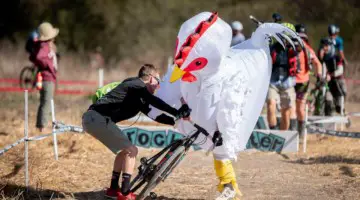Updated: The company locks down an official name, and adds an option for a single bar clamp. Stay tuned as we put some real miles on this rig!
by Andrew Yee
A week before the 2010 Cyclocross National Championships in Bend, we highlighted Tim Cannard’s “324 Brake Adapter,” a home-brewed invention that he developed to use Formula hydraulic disc brakes with his drop bar brake levers. Pushed by the demand of riding buddies and cyclocrossers like him who were unsatisfied with current braking options, Cannard continued with several months of further testing and development on his adapter. Four months after our first look and ride, one night before Sea Otter (and perhaps not coincidentally, one night after we published our exclusive first look at TRP’s Parabox hydraulic disc brake solution for cyclocross), 324 Lab’s founder Cannard and his business partner Denzil Wessels were ready to give Cyclocross Magazine an exclusive first off-road test ride of their near-production-ready 324 Brake Adapter.
Meeting in a parking lot of a park late at night may seem a little shady for a product preview, but what better testing grounds than the Wednesday Worlds cyclocross course? With the sandbaggers at home watching American Idol or Dancing with the Stars, I hopped aboard the purpose-built Rock Lobster cyclocross bike to see whether all the hype around hydraulic discs for cyclocross was deserved.
Installing the 324 Brake Adaptor requires removal of the brake levers to slide the bar clamps around the bend of the drop bar. Once the master cylinders are bolted down, the adapter’s position and configuration features a short, straight line for the brake cable along the bar to the hydraulic levers in attempt to keep friction and housing flex to a minimum under braking. The result is a light feel at the lever, not unlike modern hydraulic mountain bike levers.
It’s worth noting that much of the flats of the handlebar are occupied or obstructed by the adapter clamp, brake cable or master cylinder. If you’re always on the hoods or in the drops, you won’t care, but if you like to power through the bumps with your hands up top, you’ll have to modify your position or get used the 324’s bar clamps or other components. [Update: 324 Labs has developed a single bar clamp for both master cylinders to keep the bars clean]. Inline levers are also missing, but with the position of the master cylinder, a small hydraulic thumb lever may even be possible.
Since our initial preview, Cannard and his team have reworked the cable clamp, the bar clamp, the materials used and the lever action of the adapter, and fortunately for him, Mother Nature doused Northern California with perfect testing conditions – record rains and cold temperatures. With the harsh conditions of Bend’s National Championships still fresh in his mind and barely-thawed fingers, and thinking of the even-harsher conditions expected in Madison, Cannard said he sent one of his testers out in the slushy, near-freezing temperatures for a ride without gloves to test the wet-weather and cold-finger braking power of the levers and adapter.
The end result? From my few test laps, it’s obvious that Cannard has prioritized braking power and modulation in his setup in a way that any mountain biker used to hydraulic disc brakes can appreciate. Want to brake from the hoods with one finger? No problem. Know that you shouldn’t wreck the grass or trail with a skid, but want to do it anyway? Flick the Cane Creek brake lever, and you’re sliding through the corner, executing your best imitation of a Francis Mourey pivot turn. Facing the slick, terrifying descent of Asper Gavere? There’s no longer a big need to get in the drops and grab a handful of brake lever ala Nys.
But if you’re still sporting the massive clearance of Hogan cantilevers, you might find this setup unsettlingly strong, or perhaps even unsafe and endo-inducing. The bigger question is, does anyone need such braking power, and is it worth the nearly half pound weight penalty? It’s a personal question for sure, but in most motor-oriented sports, late, powerful modulated braking translates into more speed. Is cyclocross any different? We’re not sure, but we’re excited to ride the 324 Brake Adapter and the TRP Parabox system a lot more in the near future to find out.
Cannard said he’s almost ready to go to production and is planning on accepting pre-orders for the system in the next few weeks. Initial retail for the adapter unit (not including brakes or rotors) will be $139, and the made-in-California unit will only work with Formula R1 or Rx brakes. Stay tuned for our in-depth test of the 324 Brake Adapter.
For more info, 324 Labs website.
Photo Gallery:




























